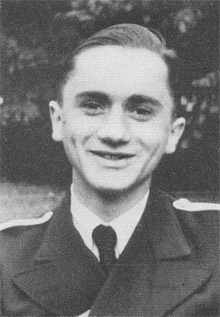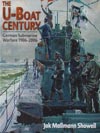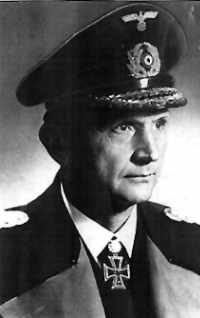 In June 1935 Admiral Raeder appointed captain Karl Dönitz (left) to the post of Commander U-boats, responsible for the training and leadership of the burgeoning U-boat fleet. Interestingly, later to be a major antagonist of Dönitz, Max Horton (appointed to command Western Approaches after the war started) had been appointed to the command of the British First Cruiser Squadron on 7 June, during the conference in London. Dönitz' influence at the time was limited but he was a convinced U-boat officer, having served in U-boats in World War One. He was very much in favour of the medium sized boat, but he seems to have had no influence on the planning decisions at the time. However the importance of the appointment was to be felt later, during the first half of the war in the Atlantic.
In June 1935 Admiral Raeder appointed captain Karl Dönitz (left) to the post of Commander U-boats, responsible for the training and leadership of the burgeoning U-boat fleet. Interestingly, later to be a major antagonist of Dönitz, Max Horton (appointed to command Western Approaches after the war started) had been appointed to the command of the British First Cruiser Squadron on 7 June, during the conference in London. Dönitz' influence at the time was limited but he was a convinced U-boat officer, having served in U-boats in World War One. He was very much in favour of the medium sized boat, but he seems to have had no influence on the planning decisions at the time. However the importance of the appointment was to be felt later, during the first half of the war in the Atlantic.
General opinion in the Navy saw the U-boat as a part of the main fleet (as did all other major navies at the time), and not as a weapon in itself, to be used against the merchant fleet of future enemies. This was in part due to German fears of the French Fleet, and the feeling that sinking merchantmen was incidental to the U-boat commander's real task of laying waste to the iron colossi on the surface. Furthermore submarines were questioned as to their efficacy due to the development of ASDIC (and see later) and pre-set fuses for depth charges in England. These, and other problems all faced Dönitz upon taking up his command in Kiel-Wik.
Then, on 28 September 1935, Dönitz was also appointed Commanding Officer of the first operational U-boat unit - the Weddigen Flotilla. His command consisted solely of U9, the Type IIB boat commissioned on 21 August 1935. He knew that his job was to become more substantial, and he was an energetic man, and so he threw himself into the job wholeheartedly, despite, as he said himself, having been appointed with "neither orders, instructions nor guidance." His command was one which was ideal to a reasonably senior officer; he had almost total freedom of choice in what he did, and how he did it. Raeder's evaluation of the man was fight. Dönitz was not entirely alone however, for a number of officers and men had already received training, and there was a corpus of experience available in the veterans of the previous war.
There had been training programmes already of course, under Admiral Spindler, which had begun in 1927, although it had naturally been theoretical. Later some sea training had been provided, thanks to Inkavos' activities, and quite a number of officers and men had also benefited from Schottky's specialised U-boat course. This course, which also ran from 1927 onwards, was divided into three sections. These were
- The origins of various submarine types, and talks on the meaning of the submarine within the field of naval warfare.
- Lectures on foreign submarines and their weapons, with a constant feedback of Intelligence from abroad, and particularly from Inkavos and the various officers who sailed on its designs.
- Talks on the basic means of maintaining depth, manoeuvring underwater, and submarine steering equipment.
- The weaponry, periscopes and the organisation of protective measures to counter anti-submarine attack.
- Lectures on attack tactics, backed up with experience from the previous war.
(All of Part A instruction was given to every young ensign of the U-boat Arm.) - Staff courses in submarine subjects (down to the rank of lieutenant). These were given from 1930 by Schottky, from 1932 by Sch?rer and F?rbringer.
- The training of small groups of serving seamen's and engineering branch officers on the various Inkavos boats. Until 1932 F?rbringer, who had crewed one of the Turkish boats, was running a submarine training school for the Turkish Navy, and three young serving officers had been attached to his staff in Turkey for some time. In addition to these special-to-arm courses, Schottky asked for, and got, lectures on U-boat matters given at the Naval School at Kiel-M?rwik, and the Naval Academy at Kiel.
Until 1932 all the training had no practical purpose, but then the first definite plans were laid for future U-boat building. Hitler supported the armed forces' expansion programmes, and the U-boat training became more formalised within the general training structure; Fürbringer was put in charge because he was the most experienced of the training officers. In May 1932 he gave his first six-day course to 49 naval ensigns. Further training plans for 1932 included starting intensive yearly courses for seamen's branch and engineering branch officers. This training was to be far more extensive, lasting twelve weeks. There were to be 207 hours teaching, and one or two hours daily on the simulator. Seatime was spent on CV707, and an increasing number of officers experienced the benefits of both theoretical and practical training. Regular courses became standard, and von Blomberg (Minister of Defence from 1933) put the matter into the normal training programme by establishing Kiel-Wik as the new submarine school from I October 1933.
The Commanding Officer was Kptlt. Karl Slevogt; the senior lecturers were Fürbringer and Hülsmann. The latter was to become one of the most senior U-boat engineering officers, and finally Chief of the U-boat acceptance board. Lecturers were Rösing (who had tested a Swedish submarine in 1932) and Freiwald (later aide-de-camp to Raeder). The first course assembled at Kiel in the summer of 1933.
The course comprised eight officers and more than 70 petty officers and ratings. Still operating as the "anti-submarine training school" this was actually the only class of this nature at the school until submarine production prospects improved in 1934. The second entry then reported on 30 September 1934. In both cases the course consisted of theoretical instruction into U-boat construction (from the point of view of both seamen and engineering branch), together with lectures on stability maintenance (including load planning and trim correction, surfaced and submerged). Seamen got basic torpedo handling training and firing, and senior rates and officers were practised in periscope use. Engineering officers went through a much more detailed description of the power units, and all other machinery for which they would be responsible once posted to a boat. Practical models of steering equipment, periscopes and gyro-compasses were used, to increase the value of the training.
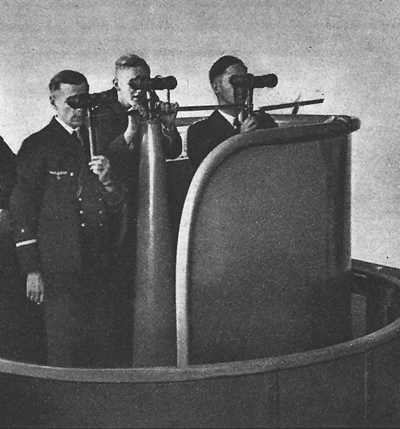
Further practical training was done on the simulator fitted in a minesweeper. A periscope stub was fitted in an enclosed deck compartment, and an engine replica gave half the power of a Type II; control was through another replica, of the submarine's steering equipment. A number of officers were trained in this way, and as many as possible sent to Finland to experience the real thing on CV707. During her extremely lengthy trials period, thanks to Fürbringer, many officers benefited from training on her, including Brafitigem, Papenberg and Freiwald.
Thus, when Dönitz took command of U-Flotilla Weddigen and "his one U-boat, he was not short of trained crews. The crews then had to undergo further training, and much of that training, which took place at Kiel and M?rwik (for ensigns and lieutenants), was concerned with Asdic, and the countermeasures to it. Dönitz was responsible for all of this. He had, as noted above, been promoted Commander U-boats on 6 June 1935, his command of Uflotilla Weddigen dating from September that year, and training was part of his job. At the time 28 seamens' branch and 9 engineering branch officers had been posted to UAS, among them Lieutenants Prien, Schepke, Sch?tze, Godt (later Admiral and Commander U-boats) and Frauenheim. All were to be 'aces' in their time.
U-Flotilla Weddigen was officially established in Kiel on 27 September, and Dönitz arrived to take command two days later. The Flotilla was planned to be equipped with U-7 - 12 (all Type IIB), but eventually received U-9,13,15,17,19,21,and 23. The last boat arrived on l0 October 1936.The training Flotilla (Usflotilla) got U-l-8, l0 and 11, which arrived between 29 June 1935 and 16 December 1936. All boats had completed acceptance trials before being put onto the Flotilla strengths.
Although Dönitz was essentially on his own as far as training and organisation was concerned, he was looking forward to the task. He wrote that he had his "own ideas about the training of the Flotilla and had set myself certain, clearly defined fundamental objectives." He went on to give details of these objectives. He said:
- "I wanted to imbue my crews with enthusiasm and a complete faith in their arm, and to instil in them a spirit of selfless readiness to serve in it. Only those possessed of such a spirit could hope to succeed in the grim realities of submarine warfare. One of the first things that I had to do was rid my crews of the ever recurring complex that the U-boat, thanks to recent developments in British anti-submarine defence, was a weapon that had been mastered...
- The U-boats had to be trained as far as possible for war conditions. I wanted to confront my U-boat crews in peacetime with every situation with which they might be confronted in war, and to do it so thoroughly that when these situations arose in war my crews would be able to cope with them.
- As the range at which a U-boat should fire, both in surface and in submerged attack, I laid down the short range of 600 yards...During the summer of 1935 the UAS had been teaching the young crews that when a U-boat discharged its torpedoes submerged, it must do so at a range of over 3,000 yards from the target, in order to avoid detection by the British Asdic apparatus...I strenuously opposed this conception...
- I considered that the U-boat was ideal as a torpedo carrier, even at night and in a surface attack. (Author's emphasis).
- The primary emphasis of my appreciations, objectives and consequent training methods had, however, to be laid on the tactical considerations. And here new problems presented themselves for solution.
- It is essential, in an attack on any given objective, to be able to deliver the attack in as great strength as possible...to bring a number of U-boats to attack simultaneously the given objective...A massed target then, should be attacked by massed U-boats.
- The U-boat has a very restricted radius of vision and is slow, even on the surface..Tactically then it must act in co-operation with a branch of the armed forces more suited to reconnaissance duties. And for these the best is the aeroplane."
This summary gives an outline of Dönitz' method, and how he trained his crews during peacetime, and what he put into effect as soon as war broke out. He had not however the size of force he required, nor the air reconnaissance facilities that he implies were needed to put the plan into immediate, and devastating, effect. First results were therefore not too encouraging, but the situation improved as numbers grew and pack tactics became more effective, until there was a danger to the Allies that the Atlantic supply routes would be cut permanently.
To ensure that all crews got a very firm grounding in general boat handling they had to make 66 surfaced and 66 submerged practice attacks before being allowed to fire their first live (practice) torpedo. Crews also trained in handling their craft in enemy waters, surfaced and submerged, inshore and off-shore. Then they were taught when to submerge when enemy aircraft or surface vessels were sighted, and when to remain on the surface; there was however one main rule, which was "dive if in doubt. " During the interminable 132 training attacks and during later training torpedo attacks they had to trim the boat to minimise periscope exposure, and. this was done at night as well. They were taught to use background light behind the target at night, to illuminate it, and to minimise their own silhouette at all times. Combined with this was training to improve seamanship in the attack, thereby using the effects of wind and sea to lessen chances of being seen. In essence they were being taught stalking tactics.
A number of tactical points were dealt with during training which had arisen from the First World War. Other matters were the product of Dönitz' close analysis of what the enemy might do, as well as what the U-boats could do. Crews were taught how to maintain contact with a target whilst, when possible, getting ahead of it. This was particularly important in convoy attacks, for only one attack might be possible, and therefore it must be effective. Crews also received instruction in 'housekeeping' - watch routines by day and by night, and how to change over routines. This is particularly important at night, when bridge watches had to be kept in a darkened space for their night vision to develop, without which they were ineffective for up to half an hour.
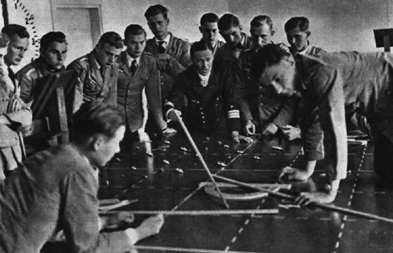
Men receive their tactical training
Further tactical training was devoted to actions to be taken by commanders when faced with enemy defensive action. Captains had to know when it was possible, and necessary, to withdraw at high speed on the surface, and when to creep away submerged. In the latter case there was an inherent danger of losing contact with the target, and so this method was reserved for situations in which the boat would otherwise have been in danger. When withdrawing they also practised zig-zag, and when escaping underwater, they learned to operate silent routines. They had repeated practice in technical control of the boat, and in diving and surfacing techniques. Above all, the crew had to learn to operate as a coherent team, at all depths and all the time. Finally they were trained in surface gunnery, and in anti- aircraft defence. The course in all lasted for a year.
One U-boat commander wrote the following about the course:
-
"The knowledge acquired during this single year of intensive training, in which the crews were tested to the limits of human endeavour, was the foundation in so far as the choice of types, armament and training were concerned, upon which the future structure of the U-boat Arm was built.
In the years that followed, tactics underwent refinement and modification. When it became evident that Britain might take the field against us, these tactics had to be modified to meet the conditions imposed by warfare on the High Seas and the introduction of the convoy system. But the principles remained unchanged. The salient feature of this training year, 1935-36, was in fact that it eradicated from the mind of all commanders and their crews the inferiority complex, which had undoubtedly been prevalent among them, and the idea that the U-boat had been mastered and rendered impotent as an instrument of war by recently developed anti-submarine devices. "
This course was standard to all crews which served in the U-boat Arm until strategic requirements forced truncation. The detail in it, and its scope, explain how Dönitz and his training staff were able to inculcate such an exceptional esprit de corps in the U-boat Arm, which considered itself an Elite within the Elite of the Navy.
National Socialism did not pervade the Navy, and long times away from base, or in such training courses, encouraged professionalism rather than any need for political justification. The greatest achievement was undoubtedly that crews were rid of the feeling of despair when faced by Asdic, and that they were welded into a first class naval force.
Whilst Dönitz was training his officers and men the military power of Germany was increasing, mainly at a far faster rate than that of his U-boat Arm. But there were slow improvements. Flotilla Weddigen had been established in. September 1935, and Flotilla Saltzwedel followed in April 1936 (with U-25 & U-26, two Type IA boats, and the first of the Type VII boats). Uflotilla Lohs was set up at the same time as Weddigen, the first boat arriving on 30 September 1935. The full complement was to be U-12, 14, 16, 18, 20, 22 and 24. The three Flotillas and the training Flotilla were the sum total of Dönitz' command until 1938, when three further Flotillas were set up, U-Flotillas Emsmann, Hundius and Wegener.
When Dönitz first assumed command he had the following units:
US Flotilla - l0 boats, Types IIA and IIB
U-Flotilla Weddigen - 8 Type IIB boats
U-Flotilla Saltzwedel - 2 Type IA, 9 Type VII boats
U-Flotilla Lohs - 7 Type II boats.
Bases for the Flotillas were Kiel (Usflotilla, Lohs and Weddigen), and Wilhelmshaven (Hundius). Kiel was chosen for the smaller boats, having immediate access to the waters of the Baltic (and the coast of Poland), whereas Wilhelmshaven had access to the Atlantic (and the French coast and lines of communication).
The new U-boat fleet was thus established, it had a commander, a training establishment, enough boats for three Flotillas and enough men trained in the basics to begin further, advanced, training in preparation for war. The commander was sufficiently experienced to do his job, and to enthuse his men. He was able to use experience in planning actively for his rble in any future war. The period from the beginning of 1936 to I September 1939 saw the U-boat fleet double in size, and the development of new U-boat types, some of which saw extended service during the war, others of which spawned new ideas, and some which disappeared from sight. Throughout the period however there existed the theme that war would come, although Raeder certainly prayed that it would not come before his balanced fleet was ready.
Next: The Preparation and training of U-boat Crews 1925-1945
